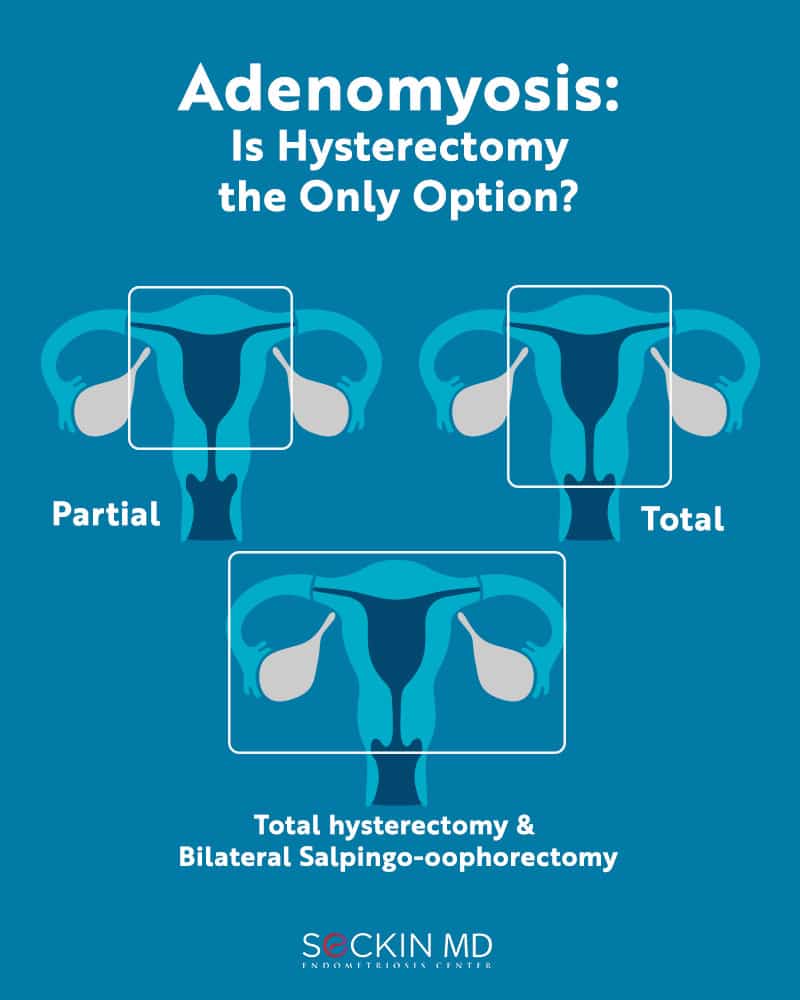Adenomyosis: Is Hysterectomy the Only Option?

Removes the uterus, not including the cervix. A patient may choose to undergo this form of hysterectomy to preserve a healthy cervix.
Total hysterectomy:
Removes the uterus, including the cervix. A patient may choose to undergo this form of surgery if there is endometriosis involving the cervix and they also wish to preserve the ovaries for possible IVF treatments and future surrogacy.
Total hysterectomy & Bilateral Salpingo-oophorectomy:
Removes the entire uterus, fallopian tubes, and uterus. A patient may choose to undergo this form of surgery if they do not wish to become pregnant in the future and want to limit their risk of ovarian cancer.
Adenomyosis is a condition in which tissue resembling the lining of the uterus grows inside the uterine muscle wall. Importantly, this disorder often coexists with other diseases of the reproductive system, including endometriosis and fibroids. But is a hysterectomy the only option to treat adenomyosis? This article discusses the symptoms of adenomyosis, the possible complications associated with it, and the different treatment options available.
Symptoms of adenomyosis
Some patients with adenomyosis are asymptomatic. Those who experience symptoms, often present with an enlarged uterus with inflammation, significant pain, and heavy menstrual periods. Other symptoms may include painful bowel movements, urinary symptoms (painful urination, blood in urine), and pain during intercourse.
Possible complications and why it is important to treat adenomyosis promptly?
Due to heavy periods, one of the main possible complications of adenomyosis is chronic anemia due to extensive blood loss and subsequent fatigue. Another complication is debilitating pain that interferes with the day-to-day life of a patient.
Adenomyosis can also lead to decreased fertility or infertility, and a higher rate of miscarriage, which can all have a great toll on a patient’s emotional and psychological wellbeing.
The timely treatment of adenomyosis is, therefore, of great importance, as is the method chosen to remove lesions.
Hysterectomy, the first choice of adenomyosis treatment for many doctors
Many doctors may think that a hysterectomy is the best and only option to treat adenomyosis. And in some cases, this could be true. However, at the Seckin Endometriosis Center, hysterectomy is not a universal solution for adenomyosis but a last resort.
Dr. Seckin believes the best approach is to try a minimally invasive approach, only performing a hysterectomy in case of very extensive disease and there is no way to save the uterus.
Importantly, when adenomyosis coexists with lesions in other areas or organs (endometriosis), hysterectomy does not solve the problem and laparoscopic excision surgery is necessary to remove the lesions outside the uterus.
As Dr. Seckin explained in a recent letter, this procedure is a patient’s choice and an autonomous decision, and it is never recommended lightly.
What other options are there?
Laparoscopic deep excision surgery is the best method to treat adenomyosis. This surgery requires advanced surgical skills, as the meticulous reconstruction of the layering of uterine muscles is necessary to ensure the possibility of future pregnancies.
The Osada procedure, a technique developed by Prof. Hisao Osada allows the patient to still become pregnant after the operation. This procedure, which Dr. Seckin has significant expertise in, prevents the heavy bleeding that would occur during surgery and eventually lead to the painful enlargement of the uterus. The surgeon opens the uterus and removes the lesions. He or she then closes it again with several layers of sutures in a way that prevents future ruptures. The approach provides great relief from the main symptoms of adenomyosis and preserves a woman’s fertility.
Have you had a hysterectomy to treat adenomyosis? Please share your experience and comment on our post on Facebook or Instagram.
Get a Second Opinion
Our endometriosis specialists are dedicated to providing patients with expert care. Whether you have been diagnosed or are looking to find a doctor, they are ready to help.Our office is located on 872 Fifth Avenue New York, NY 10065.
You may call us at (646) 960-3080 or have your case reviewed by clicking here.